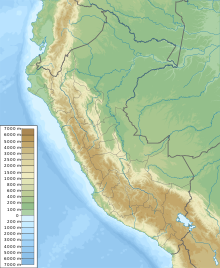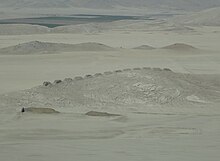Chankillo
From Wikipedia, the free encyclopedia
| Chankillo | |
|---|---|
| Alternate name | Chanquillo |
| Location | Ancash Region, Peru |
| Coordinates | 09°33′24″S 78°14′09″WCoordinates: 09°33′24″S 78°14′09″W |
| Type | Fortified sanctuary |
| Area | 4 km2 (1.5 sq mi) |
| History | |
| Founded | 300 BC |
Chankillo is an ancient monumental complex in the Peruvian coastal desert, found in the Casma-Sechin Oasis in the Ancash Department of Peru. The ruins include the hilltop Chankillo fort, the nearby Thirteen Towers solar observatory, and residential and gathering areas. The Thirteen Towers have been interpreted as an astronomical observatory built in the 4th century BC.[1][2]As of 2008, the culture that produced Chankillo is unnamed.[3]
The site covers about four square kilometres (1.5 square miles) and has been interpreted as a fortified temple.[4]
The Thirteen Towers solar observatory[edit]
The regularly-spaced thirteen towers of Chankillo were constructed atop the ridge of a low hill running near north to south and are, forming a "toothed" horizon with narrow gaps at regular intervals. To the east and west investigators designated two possible observation points. From these vantages, the 300m long spread of the towers along the horizon corresponds very closely to the rising and setting positions of the Sun over the year,[1][2] albeit they are not all visible. On the winter solstice, the sun would rise behind the leftmost tower of Chankillo and rise behind each of the towers until it reached the rightmost tower six months later on the summer solstice, marking the passage of time.[5] The Thirteen Towers of Chankillo could be the earliest known observatory in the Americas. Inhabitants of Chankillo would have been able to determine an accurate date, with an error of a day or two, by observing the sunrise or sunset from the correct tower.[6]
The towers had been known to travelers for centuries, but the astronomical function of the towers was first hypothesized in 2007 by Iván Ghezzi and Clive Ruggles.[7]











No comments:
Post a Comment